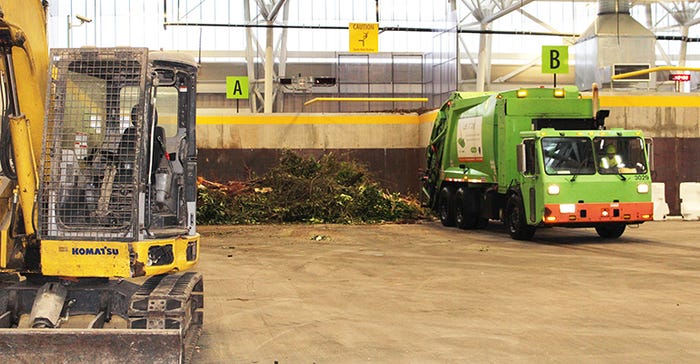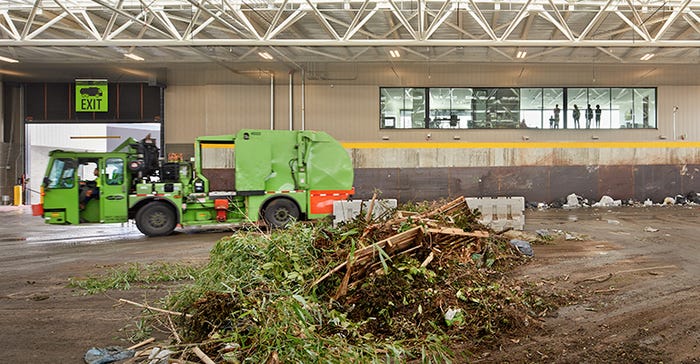Seattle’s North Transfer Station Focuses on Community Engagement, Safety
The station’s new Community Education Room provides an interactive educational experience for local residents.

With a focus on community engagement and education, as well as operational safety and efficiency, the North Transfer Station in Seattle was rebuilt as a state-of-the-art facility in 2016. In December 2017, the North Transfer Station opened its Community Education Room, which provides an interactive educational experience for local residents. Located on the second floor, the room overlooks the tipping floor.
“People get to really see and experience how the materials are moving through the station and see the large volume and scale of it,” says Becca Fong, solid waste communications and outreach planner for Seattle Public Utilities (SPU).
The education room features interactive exhibits that answer questions about recycling and composting, as well as a 10-foot-by-5-foot scale model with toy cars to illustrate the flow through the transfer station and a model compactor. Another exhibit illustrates Seattle’s solid waste history over the last 100 years and how management of waste has evolved in the community.
By allowing residents to view the operations at the transfer station, and through the exhibits, the hope is that residents will understand both the role they have to play and the work that SPU puts into managing waste in a responsible way.

“[Residents] have the biggest impact on the solid waste system by what they do. We want people to understand the magnitude of material that moves through the city and that the decisions that they make every day at their home, at work, at school, when they’re out in the community, make a big difference,” says Fong. “The second thing is that Seattle Public Utilities works really, really hard to handle it sustainably and efficiently. They have a role; there’s a lot of material, and we’re working really hard in the background to handle it as best we can.”
SPU worked with the community through a collaborative design process to create a facility with community amenities and sustainable features. The transfer station was certified as LEED Gold for its design, which maximizes energy. East of the new facility, SPU created an open space that not only buffers the adjacent neighbors from the station but also includes a play area for children, a sports court, an open lawn, walkways and static exercise stations. It also works to reduce the impact of noise and odor on the local community.
“Since we are in a residential neighborhood, we take being a good neighbor very seriously. The feedback from the community has been primarily positive, even though we know most people would prefer not to live near a transfer station. Looking at the beautiful design of the transfer station, most guests say it looks more like a library than a ‘dump,’” says Lee Momon, operations manager for Seattle Public Utilities’ North Transfer Station.

The station receives approximately 400 tons of various materials. It has two 2015 John Deere 644 hybrid wheel loaders and two refurbished Harris T500 compactors that it uses to process solid waste loads; 40-foot and 48-foot trailers that are hauled to the rail yard in South Seattle and put on a mile-long train of garbage to the landfill in Oregon; and 48-foot, open-top containers that are used for yard waste, which is hauled to waste processers. It also uses 30-foot drop boxes for separation of the recycled items, and then to save on its carbon footprint, it dumps those drop box items into a 48-foot, open-top box. To pack the loads into the open-top boxes, it uses a Komatsu PC 78 Excavator.
The transfer station helps to advance the city's recycling goals by making it easier for residents to participate. It also recently launched a partnership with Goodwill, and it will accept reusable household goods and electronics. Residents can also drop off used oil, sharps, bicycles, paper, plastic, cardboard, glass, batteries and scrap metal.
“Most days you can see people either walking in or riding their bikes into the recycle center to drop off small bags full of recyclable items, which is something that is not allowed at most transfer stations. This one-stop shop approach helps to reduce items going to the landfill, which helps advance the city’s goal of zero waste,” says Momon.
About the Author
You May Also Like


